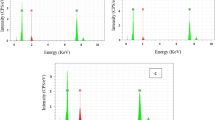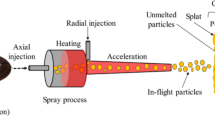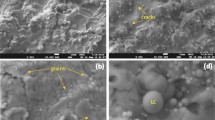Abstract
Nickel thin films with regular configuration and similar thickness were deposited on steel AISI 1018 (UNSG 10180) by two different techniques: magnetron sputtering and electrolytic process. The main aim of this work is to compare the surfaces deposited films made by the two techniques using the scanning electronic microscopy and to identify their morphological differences and imperfections. We evaluate the protective coatings properties when the films are in contact with an acid medium. We also study the thin films coatings by the spectroscopy impedance technique. We obtain that the sputtering deposits present a homogeneous thin film coating that is better than the one obtained by the electrolytic technique. It is expected that the thin film coatings made in this work can protect the steel against corrosion when it is in contact with an acid environment.
Similar content being viewed by others
References
Albarran, J.L., Martinez, L., and Lopez, H.F., Effect of Heat Treatment on the Stress Corrosion Resistance of a Microalloyed Pipeline Steel, Corros. Sci., 1999, vol. 41, pp. 1037–1049.
Tresseder, R.S., Staehhle, R.W., et al., Stress Corrosion Cracking and Hydrogen Embrittlement of Iron Base Alloy, NACE, Houston: TX, 1977.
Naki, Y., Kurahashi, H., Emi, T., and Haida, O., Macrosegregation in Steel Strands and Ingots: Characterisation, Formation and Consequences, ISIJ Trans., 1979, vol. 19, pp. 401–410.
Vacandio, F., Massiani, Y., et al., Influence of Various Nickel Under-Layers on the Corrosion Behaviour of AIN Films Deposited by Reactive Sputtering, Surf. Coat. Technol., 2001, vol. 137, pp. 284–292.
Franco, C.V., Fontana, L.C., et al., An Electrochemical Study of Magnetron-Sputtered Ti- and TiN-Coated Steel, Corros. Sci., 1998, vol. 40, pp. 103–112.
Sanders, D.M. and Anders, A., Review of Cathodic Arc Deposition Technology at the Start of the New Millennium, Surf. Coat. Technol., 2000, vols. 133, 134, pp. 78–90.
Ordine, A., Achete, C.A., Mattos, O.R., Margarit, I.C.P., Camargo, S.S., Jr., and Hirsch, T., Magnetron Sputtered SiC Coatings as Corrosion Protection Barriers for Steels, Surf. Coat. Technol., 2000, vols. 133, 134, pp. 583–588.
Mankowski, J., The Pitting Corrosion of Plasma Nitrided Chromium Steels in Sulphate Solution, J. Flis, Corros. Sci., 1993, vol. 35, pp. 111–116.
Morita, R., Azuma, K., Inoue, S., et al., Corrosion Resistance of TiN Coatings Produced by Various Dry Processes, Surf. Coat. Technol., 2001, vol. 136, pp. 207–210.
Mehmood, M., Akiyama, E., Habazaki, H., et al., The Effect of Heat Treatment on the Corrosion Behavior of Sputter-Deposited Aluminum-Chromium Alloys, Corros. Sci., 1998, vol. 41, pp. 477–499.
A.S.M. Handbook Corrosion, 9th, Ed. by American Society of Metals, USA: International Committee, 1992, vol. 13.
Abdusalam, M.I. and Pickering, H.W., Effect of the Applied Potential on the Potential and Current Distributions within Crevices in Pure Nickel, Corros. Sci., 1999, vol. 41, pp. 351–352.
Cheng, X., Ma, H., et al., Corrosion of Nickel in Acid Solutions with Hydrogen Sulphide, Corros. Sci., 2000, vol. 42, pp. 299–311.
Czerwinski, F. and Szpuunar, J.A., Controlling the Surface Texture of Nickel for Hightemperature Oxidation Inhibition, Corros. Sci., 1999, vol. 41, pp. 729–740.
De Gromoboy, T.S. and Shreir, L.L., The Formation of Nickel Oxides during the Passivation of Nickel in Relation to the Potential/pH Diagram, Electrochim. Acta, 1996, vol. 11, pp. 895–904.
Perdomo, J.J. and Song, I., Chemical and Electrochemical Conditions on Steel under Disbonded Coatings: the Effect of Applied Potential, Solution Resistivity, Crevice Thickness and Holiday Size, Corros. Sci., 2000, vol. 42, pp. 1389–1415.
Seah, K.H.W., Thampuran, R., and Teoh, S.H., The Influence of Pore Morphology on Corrosion, Corros. Sci., 1998, vol. 40, pp. 547–556.
Park, H. and Szpuunar, J.A., The Role of Texture and Morphology in Optimizing the Corrosion Resistance of Zinc-Based Electrogalvanized Coatings, Corros. Sci., 1998, vol. 40, pp. 525–545.
Author information
Authors and Affiliations
Corresponding author
Additional information
The article is published in the original.
About this article
Cite this article
Magaña-Zavala, C., Angeles-San Martin, M.E., Rodríguez-Gómez, F.J. et al. Comparative study of the morphological degradation in nickel thin films exposed to H2S media and deposited by magnetron sputtering and electrolytic process. Surf. Engin. Appl.Electrochem. 46, 115–119 (2010). https://doi.org/10.3103/S1068375510020055
Received:
Published:
Issue Date:
DOI: https://doi.org/10.3103/S1068375510020055




